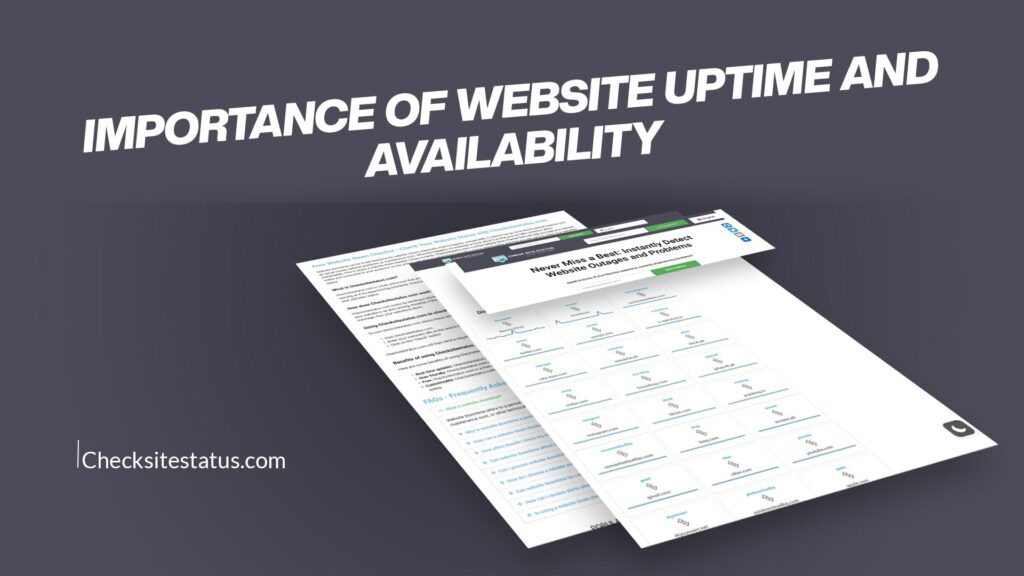In today’s digital world, a website is often the first point of contact between a business and its customers. If your website is down, you risk losing potential sales, damaging your reputation, and hurting your search engine rankings.
Website uptime and availability are two critical metrics that determine how reliably your site stays online. While they are related, they measure different aspects of website performance.
In this guide, we’ll explore:
What does uptime and availability mean
The key differences between them
Why do they matter for businesses
How to monitor and improve them
The best tools (including Check Site Status) to track outages
Let’s dive in!
What Is Website Uptime?
Website uptime refers to the time your website is operational and accessible to users. It is usually measured as a percentage over a given period (e.g., 99.9% uptime).
How Uptime Is Calculated
Uptime is calculated using the formula:
Copy
Download
Uptime (%) = (Total Time - Downtime) / Total Time × 100
For example, if your website was down for 1 hour in a month (720 hours), your uptime would be:
Copy
Download
(720 - 1) / 720 × 100 = 99.86%
Common Uptime Standards
99.9% (“Three Nines”) – About 43 minutes of downtime per month
99.99% (“Four Nines”) – Just 4 minutes of downtime per month
99.999% (“Five Nines”) – Only 26 seconds of downtime per month
Most businesses aim for at least 99.9% uptime, while mission-critical services (like banking) require 99.99% or higher.
What Is Website Availability?
While uptime measures whether a site is online, availability considers both uptime and performance. A website may be “up” but still experience slow loading, errors, or partial outages.
Factors Affecting Availability
Server response time – How quickly the server processes requests
Page load speed – Affects user experience and SEO
Third-party services – APIs, payment gateways, or CDNs failing
Geographical accessibility – Some regions may experience outages
Availability vs. Uptime Example
| Scenario | Uptime Status | Availability Status |
|---|---|---|
| Website fully operational | ✅ Up | ✅ Available |
| Website loads, but very slowly | ✅ Up | ❌ Partially Available |
| Website down completely | ❌ Down | ❌ Unavailable |
Uptime vs. Availability – Key Differences
| Factor | Uptime | Availability |
|---|---|---|
| Definition | Measures if the site is online | Measures if the site is usable |
| Scope | Binary (Up/Down) | Includes performance & functionality |
| Measurement | Based on the server response | Includes speed, errors, and UX |
| Impact | Affects basic accessibility | Affects user satisfaction & SEO |
Key Takeaway:
Uptime tells you if your site is running.
Availability tells you if users can actually use it properly.
Why Website Uptime and Availability Matter
1. Lost Revenue
Amazon once lost $5 million per minute during an outage.
Small businesses can lose thousands per hour if their e-commerce site crashes.
2. Damaged Reputation
Users expect 24/7 access. Frequent downtime leads to distrust.
Negative reviews and social media complaints can harm brand image.
3. SEO Rankings Drop
Google penalizes sites with frequent downtime.
Slow loading times hurt rankings (Core Web Vitals matter).
4. Customer Retention Issues
40% of users abandon a site if it takes more than 3 seconds to load.
If a competitor’s site is more reliable, users may switch.
Understanding Web Hosting Uptime and Downtime
What Causes Downtime?
Server Overload – Traffic spikes crash the server.
Cyberattacks – DDoS attacks or hacking attempts.
Software Bugs – CMS, plugin, or script failures.
Human Error – Misconfigurations or accidental deletions.
Hosting Provider Issues – Poor server maintenance.
How to Minimize Downtime
✔ Choose a reliable hosting provider (look for 99.9 %+ uptime guarantees).
✔ Use a CDN (Cloudflare, Akamai) to distribute traffic.
✔ Monitor with tools like Check Site Status for real-time alerts.
✔ Set up automatic backups to restore quickly.
How to Monitor and Improve Website Uptime
Best Practices for Maximum Uptime
Use Uptime Monitoring Tools
Check Site Status – Free, instant website status checker.
UptimeRobot, Pingdom, StatusCake – Advanced monitoring.
Optimize Server Performance
Upgrade hosting (VPS or dedicated servers for high traffic).
Enable caching (Redis, Varnish).
Implement Failover Systems
Use backup servers that activate if the primary one fails.
Regularly Test for Vulnerabilities
Scan for malware, outdated plugins, and security flaws.
Best Tools for Uptime Monitoring
| Tool | Key Features | Best For |
|---|---|---|
| Check Site Status | Free, instant checks, no sign-up needed | Quick manual checks |
| UptimeRobot | Free tier, 5-minute checks | Small businesses |
| Pingdom | Advanced analytics, real-user monitoring | Enterprises |
| StatusCake | SSL monitoring, speed tests | Developers |
99.9% is the industry standard. 99.99% is ideal for critical services.
Use Check Site Status – enter your URL for instant results.
Yes, frequent outages can lead to lower rankings in Google.
Some hosts offer uptime guarantees with SLA-backed refunds.
- Choose reliable hosting.
Monitor with tools like UptimeRobot.
Optimize server resources.
Conclusion
Website uptime and availability are non-negotiable for online success. While uptime ensures your site is online, availability guarantees a smooth user experience.
To stay ahead:
✅ Monitor regularly with tools like Check Site Status.
✅ Optimize performance (speed, security, backups).
✅ Choose reliable hosting with strong uptime SLAs.
By prioritizing uptime and availability, you protect revenue, reputation, and search rankings. Start monitoring today! 🚀

